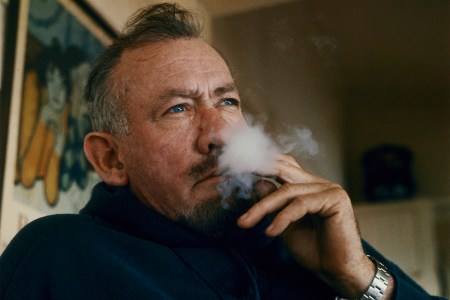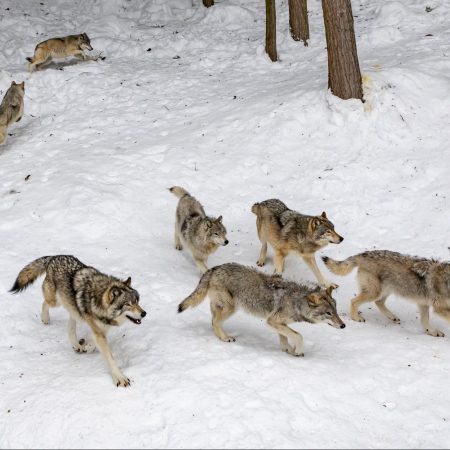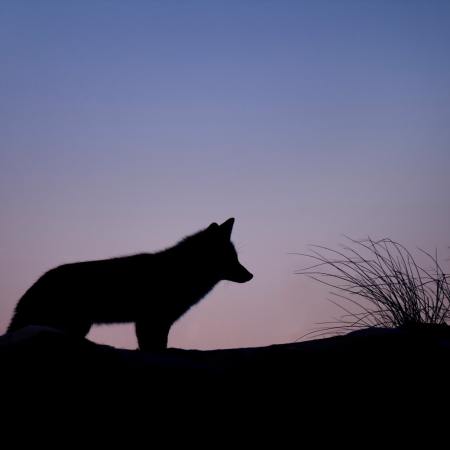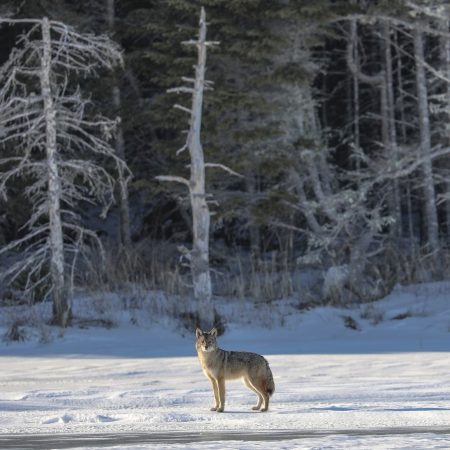Erica Berry’s new book Wolfish: Wolf, Self, and the Stories We Tell about Fear isn’t an easy work to pin down. It’s a work of nonfiction that includes a number of pages about humans and wolves interacting — some drawn from Berry’s own experience. It’s also a work of history, with Berry pondering some of the ways in which the United States has addressed wolves over the years — particularly in Oregon, a state whose fraught history is covered in depth here.
But it’s not just about those things. Berry also incorporates the ways that humans have talked about wolves over the centuries, from their place in folklore to the frequently-used metaphors that evoke them. It’s an intriguing and complex book — but also an eminently readable one. It’s also very likely that you’ll learn some things about wolves that you never knew before — including the fact that the wolves on the set of director Neil Jordan’s The Company of Wolves were thoroughly unnerved by the presence of a nearby duck.
We spoke with Berry about the genesis of Wolfish and some of the global history that informed it.
InsideHook: In Wolfish, you wrote a lot about wolves and folklore — notably, a lot of English folklore. Are wolves as menacing presences in folklore confined to one geographic region or did you find in your research that it was something that was more of a universal source of anxiety for people?
Erica Berry: A lot of the time you look at stories that appear with wolves in Western folklore and they have very similar root stems. For Little Red Riding Hood, there’s a story with a tiger that had Chinese roots, for example. There’s the same scaffolding for the story, but the animal was swapped out; there were some similar stories, I think, with a leopard in Africa.
This is an inherent limitation of the book. I was looking at the Western folklore that I had most imbibed and was most steeped in. But it is really fascinating to see the ways that in idioms — I would say idioms are different than folklore, but both tend to be these allegorical lessons on how to live in the world that parents would tell children. And there are definitely some great idioms. The big bad wolf as that sort of idea that I was really familiar with from Western folklore — that did seem more specific to Western Europe. It’s a different sort of wolf, I guess, that is conjured in different areas.
This isn’t quite a question, but I loved the detail about how the wolves brought in for scenes for the film The Company of Wolves were unsettled by the presence of a duck. I might have to start bringing ducks with me when I walk through the woods.
“Dogish” isn’t really a word, but sometimes wolves are just very dogish in that way. They get kind of distracted — saying hi to this and looking at that and then getting scared. There was this quote that I heard from one of the volunteer coordinators that wolves are scared until they’re taught not to be. I think about that idea a lot.
In Japan that goes back to another idea that is just fascinating, because in a culture where originally you’re not cattle producing but you’re grain producing, the wolf is actually helping. The wolf is the one scaring away the deer. The wolf is the farmer’s aid in the Ainu culture and some of these older indigenous Japanese cultures, which was really fascinating. It wasn’t until the birth of the cattle industry, which was spurred by American involvement, that the wolf became the problem there.
One of the things you wrote about that I found especially interesting was the idea that wolf/dog hybrids are more dangerous to humans than wolves are.
Part of that might be the framing of expectations. Wolf/dog hybrids are kept in houses where people approach them. They’re not allowed as a kind of wildlife. I’m not sure whether or not a wolf/dog hybrid out in the wild would attack humans more if it wasn’t predisposed to humans. I’m not sure that there’s that research, but there is the idea that you bring this thing into the house and you think it’s familiar and it’s really not. That’s where you have big problems. Those lines are really interesting.
I had a whole other thread sort of thinking about how government biologists are working to try to make sure that wolves do not breed with dogs. They’re very worried about that happening and there have been cases of them trying to separate these lovers that appear where you’ll have a dog that falls in with a wolf. There are a lot of fears of what will happen if they were to breed naturally. I think that’s a whole other interesting area.
Wolfish contains a lot of writing about wolves – but coyotes showed up in the narrative a lot as well. How did you decide what you were going to incorporate here and what you were doing to leave out?
That was really one of the challenges with a project like this. I was reading about the coyote and the parallel lines of coyotes and wolves throughout history. There are some studies that show that coyotes may have actually benefited from things like when bounties were offered for the killing of wolves. This was very common in early America up until wolves were extirpated in the mid 20th century. The coyotes were flourishing while the wolves were being vilified.
I was trying to sort of progress a certain question about fear — my relationship with how we are metabolizing it or how we’re raised with certain stories and enact those stories in our lives. And so when it came down to it, I felt like I had certain wolf research into real wolves that I was trying to Tetris into each chapter. I had the policy, the science and then these symbolic wolves. I also had a more conceptual meta-narrative around my own relationship with fear and the ways that that was echoing off of the research I was studying.
I noticed that Angela Carter’s fiction came up a lot in Wolfish. If you were putting together a reading list of notable wolf-centric books, what would be on it?
I love Ursula K. Le Guin’s story about the werewolf. Have you read it? It’s about a page long. It’s called “The Wife’s Story,” which is critical because you don’t know that the character who’s eventually revealed to be a wolf is a wolf. It really plays into a sort of fairy tale idea in an astounding way.
Besides that? Matt Bell’s flash fiction collection Wolf Parts, Karen Russell’s St Lucy’s Home for Girls Raised by Wolves, Charlotte McConaghy’s Once There Were Wolves, Maria Adelmann’s new novel How to Be Eaten, Lu Jiamin’s Wolf Totem. I would say future Boy Scout-founder Ernest Thompson Seton’s account of hunting a wolf (“Lobo: The King of Currumpaw”) also belongs in some big canon even if it’s nonfiction (at least in bones).
One of the other big threads in the book is Oregon. Do you think you would have ended up writing this book if you hadn’t had such a connection to the state of Oregon from the outset?
I think when I learned that Oregon’s founding was sort of based on this dream of “extirpating walls” and also a sort of white supremacist idea of creating the “pure, controlled landscape.” (Air quotes around all of that, obviously.) That felt like a particularly granular example of the ways that the othering of wolves and the othering of people are really tied together. That was the first thread that made me want to think more about this.
There’s so much incredible writing about wolves that many biologists and academics have written on the subject, but I didn’t feel like that addressed the ways that people are animalized rhetorically, and also the way animals are vilified and personified. I felt like I’d really seen that played out, and I think Oregon suddenly gave me this great case study for the way that that actually happens. It was tied very closely to a kind of mythology of the West that I had grown up with. I don’t think I would have written this book if I didn’t have the family history I did — my grandfather had sheep and my other grandparents live in Montana where wolves were around their horses and other animals. Being aware of the wolf not just conceptually, but in terms of actually kind of understanding the ways that I would feel like this was a threat to the animals that I was taking care of every day — because I did have those experiences.
Oregon was an interesting sort of example of a lot of these attitudes that have been sort of ingrained in the real DNA of statehood and nationhood and the American concepts of urban and rural and “civilized” and “uncivilized” and all of that.
How much of that history did you know sort of when you sat down to begin this and how much of that came from researching the state’s history more fully?
The first government meetings in Oregon were called the Wolf Meetings, and I never heard of them until researching this for my thesis. At the time I was looking at it from an environmental studies perspective and thinking, “I’m just going to write about the policy.” And then I started thinking about this early folklore that was inherited with colonialism. Tracing those back and realizing that as long as Oregon’s been here, there’s been this vitriol. Ways of controlling wolves are so often ways of controlling humans. And in this early American history, it was a way of dispossessing indigenous people of their relationship with the land. And you see this with killing bison as a way to create herds for white farmers or ranchers.
There were these bounties, where tribal members would have to deliver a wolf head in order to get grain or that sort of thing. So really, in the most serious way, colonialism was tied to the extirpation of wolves. I just don’t think that I’d heard in the environmental books that I was reading. I wanted to write into that space and think about how those sort of, these are the same people making the same decisions for the same goals.
John Steinbeck Wrote a Murder Mystery About a Werewolf, But His Estate Won’t Publish It
Gavin Jones, a professor at Stanford, is advocating for the book’s releaseOne of the other threads in the book involves the way humans follow specific wolves — OR7 features prominently in the book — via tracking cameras. Do you see the reactions to that and things like Fat Bear Week as a way for people to assign human qualities onto wild animals?
Part of what I think is interesting about wolves are the popular conceptions of them. The idea of the lone wolf is really mythologically potent, and so is the idea of the wolf pack. I can’t think of another animal in quite the same way that’s become a lone traveling figure.
There’s this obituary that Susan Orelan wrote in The New Yorker for this wolf that wandered furthest south in Southern California. The degree to which the wolf has been popularly villainized is almost proportional to the degree that it is now championed.
You see people tracking mountain lions, and I’ve been very interested in some of that, but I just think they have a quieter presence. Part of it comes from how hearing a howl becomes this kind of breadcrumb in the ground where you don’t quite see the thing. But the way that they move, the intrigue is heightened, right? Because you see the tracks, but you rarely see the wolf. One rancher referred to wolves as really ghostly in their presence. That feels like that’s increased the sort of mystery around them, just by the nature of their biology.
In Wolfish, you wrote a lot about your personal interactions with wolves. Has that changed at all as a result of you writing this book?
I would say that when I am out in wolf country hiking around, I don’t feel any fear. And I don’t feel even if I’m alone. The book has made me feel a lot of gratitude and honor for wanting to go out in those spaces and the ways that we’re sharing the land in a way that isn’t always obvious. But we’re sort of dancing around each other and looking for those signs. I’m attuned to it in a different way and would like to continue to put myself in the presence of those who will swim that way.
There’s currently a new pack on my side of the mountains in Oregon. And I would say that it does make me feel a little sparkle of possibility. I’m interested to see how, as we’ll continue to repopulate the west, and potentially become a little bit bolder, and maybe they just are coming into more anthropogenic food sources, like how that changes those narratives.
But yeah, I’m still waiting for that moment of like, really turning the corner and seeing a wolf down in some distant valley and like being able to sit with the feeling of how this wolf is not out to get me, and I’m not out to get it.
This article was featured in the InsideHook newsletter. Sign up now.






















